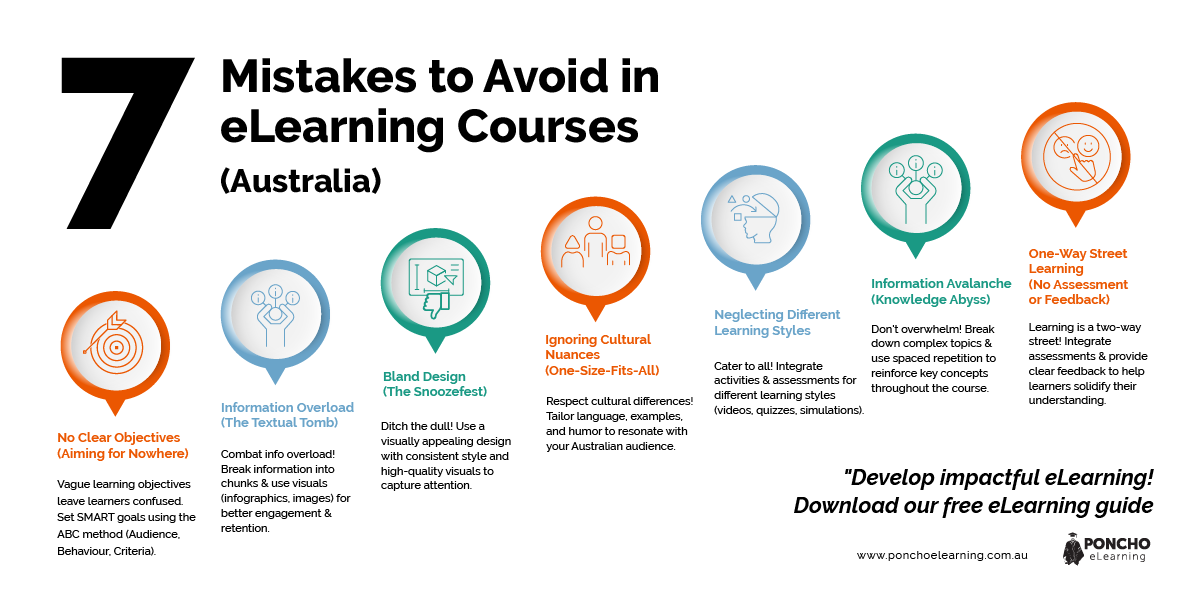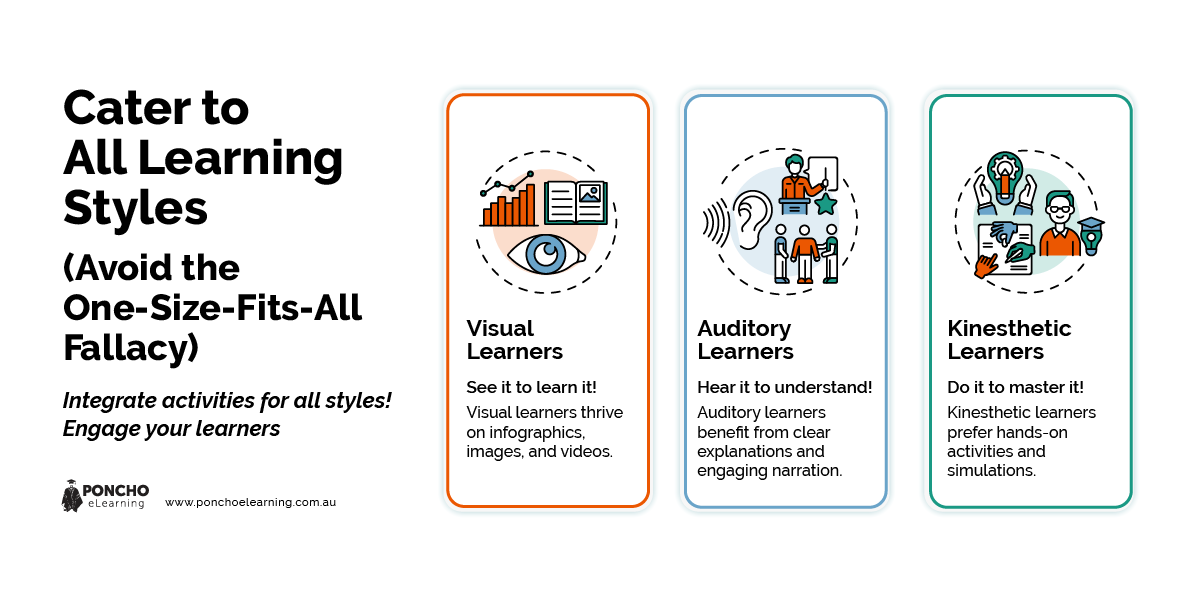Crafting engaging and effective eLearning courses in Australia requires careful planning and attention to detail. While the benefits of eLearning are vast, from improved knowledge retention to increased accessibility, common pitfalls can hinder the learning experience for your audience.
What is the best eLearning course developer in Australia?
The Australian eLearning landscape is brimming with talented developers, but here at Poncho eLearning, we take immense pride in the quality and impact of our work. Our team’s passion for instructional design and commitment to mobile-first learning make us a trusted choice for businesses and organisations looking to develop impactful eLearning courses.
So, how can you ensure your eLearning courses in Australia resonate with learners and achieve your desired learning outcomes? Here, we’ll explore seven common mistakes to avoid during the eLearning development process:

1. Neglecting Clear Learning Objectives: Aiming for Nowhere
Imagine enrolling in a course with no clear idea of what you’ll learn by the end. Confusing, right? The same goes for eLearning. Vague learning objectives leave learners feeling lost and unsure of the intended takeaways.
The Fix:
- Start with the end in mind: Before diving into content creation, define the overall goal of your eLearning course in Australia. Ask yourself: “What do I want learners to be able to do by the end of this course?”
- SMART Objectives are Your Friend: Break down your overarching goal into specific, measurable, achievable, relevant, and time-bound (SMART) objectives using the ABC method (Audience, Behaviour, Criteria).
Example: Target Audience (A)- New salespeople. Desired Behaviour (B)- Identify customer pain points and explain solutions. Criteria (C)- Measured by a role-playing assessment. - Communicate Clearly: Clearly communicate these learning objectives at the beginning of your eLearning course. This sets expectations, helps learners focus, and allows them to track their progress throughout the course.
2. The Textual Tomb: Information Overload and the Dreaded Slide Deck Syndrome
Let’s face it, learners are bombarded with information on a daily basis. Dense blocks of text in your eLearning courses are a recipe for disengagement and forgetting.
Think of those dreaded slide decks filled with paragraphs of text, information overload at its finest!
The Fix:
- Chunking for Effective Learning: Break down complex topics into smaller, manageable chunks. Aim for modules that can be completed in 10-15 minutes, allowing learners to focus and retain information more effectively. Utilise chunking techniques like spaced repetition to reinforce key concepts throughout the course.
- Visual Appeal Matters: Use visuals like infographics, diagrams, and images to represent information in a clear and concise way. Well-designed visuals can enhance understanding, improve recall, and make the learning experience more engaging.
- Multimedia Magic: Integrate multimedia elements like videos, animations, and interactive elements to make the learning experience more interactive and engaging. Consider incorporating case studies and real-world examples specific to the Australian context to illustrate key concepts and make them more relatable for your target audience.
3. The Visual Void: Failing to Leverage Design Power
Think of a beautifully designed website versus a cluttered one. The visual appeal plays a significant role in user experience.
The same applies to eLearning courses. Dull interfaces with bland stock photos do little to capture attention or promote knowledge retention.
The Fix:
- Invest in Visual Appeal: Create a visually appealing and professional design for your eLearning courses in Australia.
- Consistency is Key: Maintain a consistent visual style throughout the course, including colour scheme, fonts, and imagery. This creates a sense of professionalism and makes the learning experience more cohesive.
- Quality Counts: Use high-quality visuals that are relevant to the content and visually appealing to your target audience. Stock photos can be helpful, but consider using custom-designed elements or Australian-specific imagery to enhance the local connection.
- Interactive Elements Engage: Incorporate interactive elements like drag-and-drop activities, simulations, quizzes, and branching scenarios to enhance engagement and reinforce learning. Learners retain information better when they actively participate in the learning process.
4. Ignoring Cultural Nuances: When One Size Doesn’t Fit All
Australia boasts a rich and diverse cultural landscape. Failing to consider these cultural nuances in your eLearning courses in Australia can lead to misunderstandings and hinder the learning experience.
The Fix:
- Tailor Language and Examples: Tailor your language and examples to resonate with Australian learners. Use clear, concise, and culturally appropriate language that avoids slang or jargon unfamiliar to your target audience.
- Mind the Cultural References: Be mindful of potential cultural references that might not translate well for a diverse audience. Jokes, idioms, or metaphors specific to a particular subculture could be confusing or even offensive.
- Embrace local flavour: Consider incorporating elements of local humour or cultural references to make the learning experience more relatable. This can help learners connect with the content on a deeper level and feel more engaged.

5. The One-Size-Fits-All Fallacy: Catering to a Single Learning Style
Adults learn in different ways. Some are visual learners who thrive on infographics and videos. Others are auditory learners who benefit from clear explanations and engaging narration. Kinesthetic learners, on the other hand, prefer hands-on activities and simulations.
The Fix:
- Variety is the Spice of Learning: Integrate a variety of learning activities and formats into your eLearning courses in Australia. This caters to different learning styles and keeps the learning experience engaging for a broader audience.
- Apply Your Knowledge: Offer opportunities for learners to apply their knowledge through interactive exercises and real-world scenarios in an Australian context. This helps them solidify their understanding and see the practical applications of the information presented.
- Assessment for All: Consider including quizzes and assessments that cater to different learning styles. Include multiple-choice questions, open-ended prompts, and even drag-and-drop activities or simulations to assess understanding in a way that resonates with various learners.
6. The Knowledge Abyss: Underestimating Chunking Power
Trying to cram too much information into a single eLearning module is a recipe for overwhelm. Learners struggle to absorb and retain information presented in large chunks.
The Fix:
- Bite-Sized Learning: Break down complex topics into bite-sized learning modules. Aim for modules that can be completed in 10-15 minutes, allowing learners to focus and retain information more effectively.
- Spaced Repetition Reinforces: Utilise chunking techniques like spaced repetition to reinforce key concepts throughout the course. This involves presenting information in smaller doses at spaced intervals, which has been proven to enhance long-term memory and knowledge retention.
7. Neglecting Assessment and Feedback: A One-Way Street Doesn’t Lead to Learning
Learning is a two-way street. Relying solely on information delivery without assessing knowledge retention and providing feedback limits the effectiveness of your eLearning course.
The Fix:
- Formative Assessments Throughout: Integrate formative assessments throughout your eLearning course in Australia. Quizzes, polls, interactive activities, and even branching scenarios can gauge learner understanding and identify areas that require clarification.
- Constructive feedback is Key: Provide clear and constructive feedback on assessments to help learners solidify their understanding and improve their performance. Feedback like this needs to be immediate, actionable, and specific.
- Self-Reflection and Application: Consider incorporating opportunities for self-reflection and knowledge application through exercises and real-world scenarios in an Australian context. Encourage learners to reflect on their learning journey, apply their new knowledge to solve problems, and consider how the information can be used in their specific roles or situations.
By avoiding these common mistakes and focusing on best practices, you can develop eLearning courses in Australia that are engaging, informative, and effective.
Crafting eLearning Courses in Australia
At Poncho eLearning, we understand the unique needs of Australian learners and the importance of cultural relevance.
Our team of experienced instructional designers creates eLearning courses in Australia that resonate with your target audience and achieve your desired learning outcomes.
We take pride in developing mobile-first eLearning solutions, ensuring your courses are accessible and engaging on any device.
Ready to take your eLearning in Australia to the next level?
Contact Poncho eLearning today to discuss your project and explore how we can help you develop impactful and engaging eLearning courses for your Australian audience.




